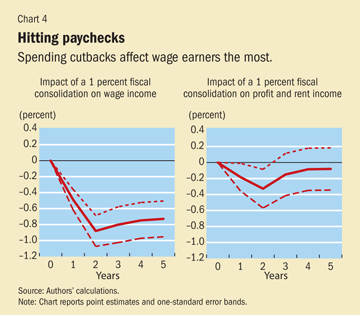Wednesday, September 14, 2011
New York Times, Huffington Post and the Washington Post on the recent F&D article
In the New York Times, Paul Krugman writes that “In the first half of last year a strange delusion swept much of the policy elite on both sides of the Atlantic — the belief that cutting spending in the face of high unemployment would actually create jobs. I went after this stuff early and hard (I suspect that the confidence fairy will be one of my lasting contributions to economic discourse); still, it’s good to have a steadily mounting weight of evidence about just how wrong that view was. The latest entry is a comprehensive review of past episodes of austerity by economists at the IMF, from which the figure above [below, Chart 3] is taken. Yes, contractionary policy is contractionary.”
Alexander EIchler of the Huffington Post summarizes the article: “The report, published in the new issue of Finance & Development, the IMF’s quarterly magazine, argues that moving too rapidly to enact so-called austerity measures — in other words, taking steps to shore up national finances and bring down debt by cutting spending and raising taxes — will hurt income in the short term and worsen unemployment in the long term.”
And, Brad Plumer of the Washington Post writes that “More specifically, an austerity program that curbs the deficit by 1 percent of GDP reduces real incomes by about 0.6 percent and raises unemployment by almost 0.5 percentage points. What’s more, the IMF notes, the losses are twice as big when the central bank can’t cut rates (a good description of the present.) Typically, income and employment don’t fully recover even five years after the austerity program is put in place. There’s also a class dimension here: A deficit cut of that size tends to cause real wage income, where lower-income folks get their money, to shrink by 0.9 percent, whereas rents and profits, which higher-income folks depend on, decline by just 0.3 percent. And, as the chart on the right shows [below, Chart 4], profits tend to bounce back faster than wages.”
Posted by at 12:46 AM
Labels: Inclusive Growth
Subscribe to: Posts

